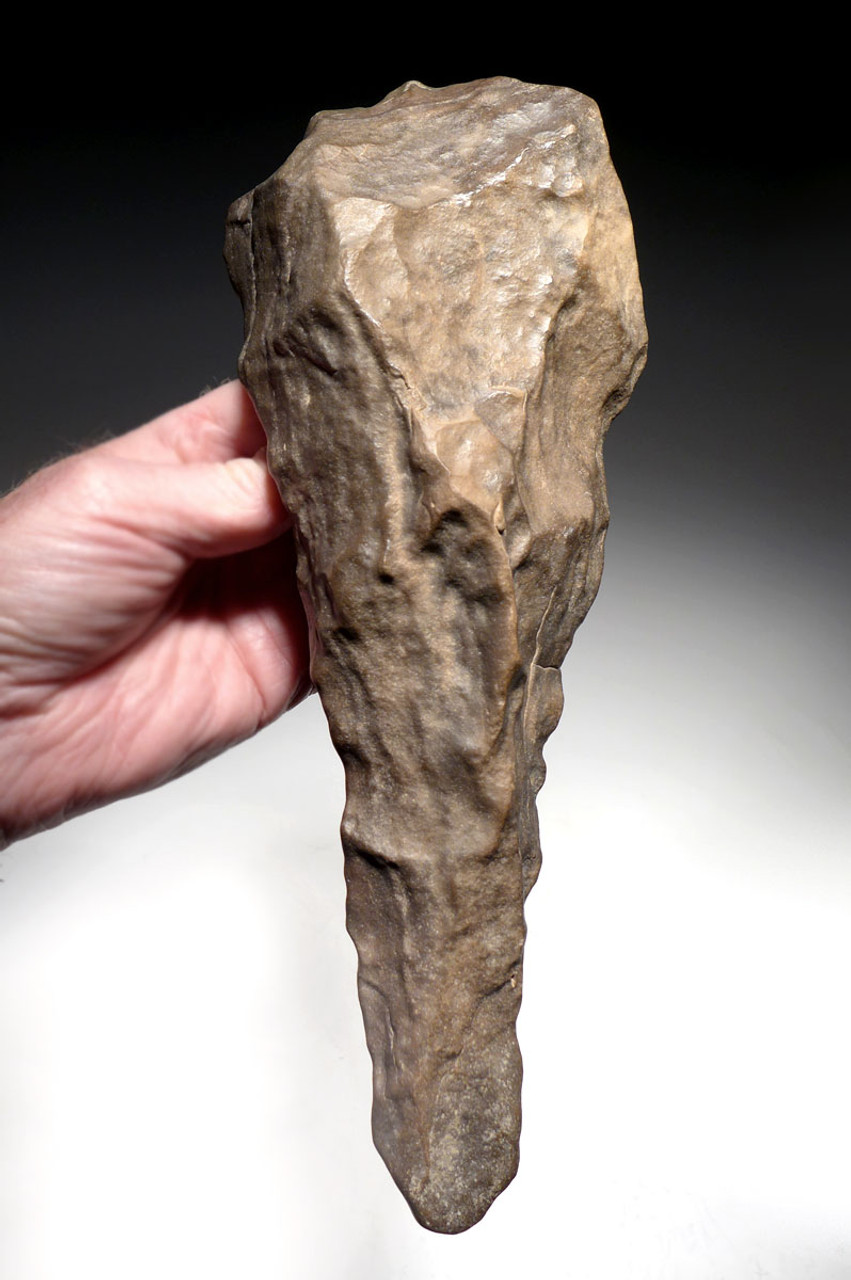Product Description
SEE MORE LOWER PALEOLITHIC ACHEULEAN STONE ARTIFACTS
This genuine Acheulean FICRON hand axe was made and used by early humans of the primitive species Homo erectus (ergaster). It was surface-collected from an exposed Lower Paleolithic Acheulian site in the Sahara Desert of Northwest Africa. Acheulean Lower Paleolithic hand axes from Africa represent the first scientifically documented intelligent tool made by primitive humans. Prior to these Saharan Acheulean handaxes, only crude pebble and flake tools existed in the human fossil record.
As one of the most beautiful and finest made Lower Paleolithic African hand axes we have ever sold, this remarkably aesthetic Acheulean bifacial FICRON hand axe should not be missed by advanced collectors. The ficron type hand axe is a unique design with an unusually long and narrow body, often with a concave tapering to the tip. This design type is also would have been the MOST DIFFICULT to flake meaning exceptional specimens like this were the masterful handiwork of extremely highly-skilled early humans! They were the superstar artisans of prehistory! Furthermore, flaking a hand axe of this EXTRAORDINARY LARGE SIZE AND PERFECT SYMMETRY means that it could have easily been considered more of an exhibit of prestige and accomlishment rather than this massive specimen with perfect form being one that would have been practical to flake and then just leave discarded by a hunting kill site! This hand axe demonstrates ARTISTIC APPRECIATION and ARTISAN PRIDE, as well as the skill and ability of Early Man's ability, to the highest order. It features every possible aspect of a prize specimen, not to mention its extraordinary size! Hand axes of this magnitude are theorized to be PRESTIGE PIECES.
The flaking on this example is superb and shows masterful craftsmanship from its primitive human creator. Light blushes of orange on one side caused by millennia of this side facing down and absorbing the minerals of the Saharan red sands. Other side shows a slightly different contrasting hue - a prized trait only found in authentic Lower Paleolithic specimens from the Northwestern Sahara. The chopping tip and edges are intact and well-made with evidence of original prehistoric primary and secondary flaking. Surface areas of the axe display a "desert varnish" - a natural glossy surface where the artifact lay undisturbed and exposed to blowing sands, for millennia. The wind-driven sand polished and deposited microscopic layers of silica on the surfaces of the artifact, giving it a sheen. Original sediment and mineral encrustations are still present in microscopic crevices and on some surfaces - a trait ONLY found in authentic Paleolithic artifacts like these. These features are a testament to the age and authenticity of ALL Saharan Paleolithic artifacts.
To date, this is one of the largest and finest Saharan Acheulian hand axe we have offered since we first went online in the year 2000. Not only is this large Lower Paleolithic African hand axe in supreme original condition, it shows incredible flaking and form made way beyond what was necessary for a utilitarian purpose. This leads many to theorize that these hand axes were the earliest form of art, flaked by master toolmakers to a degree that conveys prestige, status and achievement. Seldom will you find examples of this size, condition and form, ever available for sale.
Genuine Saharan Acheulean hand axes of this quality are rare and recent realized prices at major auction houses are proving what we have been saying for years that authentic high grade tools of primitive man remain one of the most promising investments. Specimens like this are one in many, many thousands and are exceptionally rare. Collectors consider prized features to include either size, workmanship or color but when ALL exist, then it is truly an important piece to include in a collection as this one is.
HISTORY
During this time in prehistory when this Lower Paleolithic tool was made, the Sahara Desert (where this stone tool was found) was a savanna rich in wildlife. Prior to the prehistoric global warming that turned the vast region to desert, early humans lived alongside prehistoric giraffe, bison and elephant, which were vital to their survival. Hunting and butchering these animals would have required specialized tools such as those found in the Acheulian Period.
 US DOLLAR
US DOLLAR
 EURO
EURO
 AUSTRALIAN DOLLAR
AUSTRALIAN DOLLAR
 CANADIAN DOLLAR
CANADIAN DOLLAR
 POUND STERLING
POUND STERLING


























